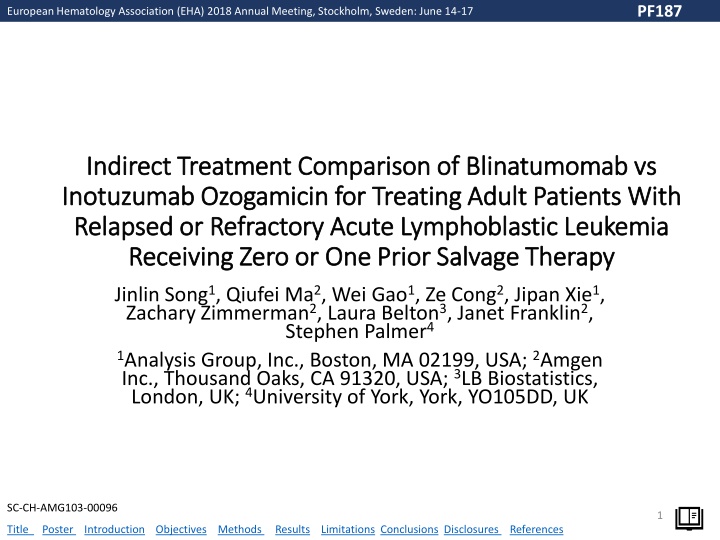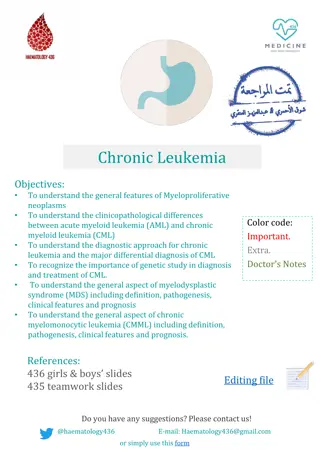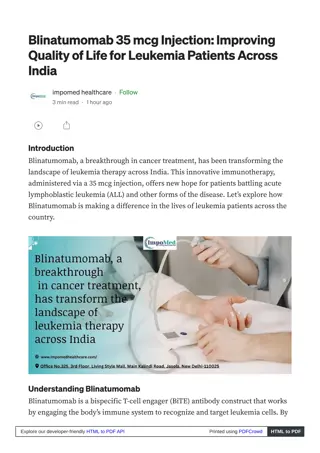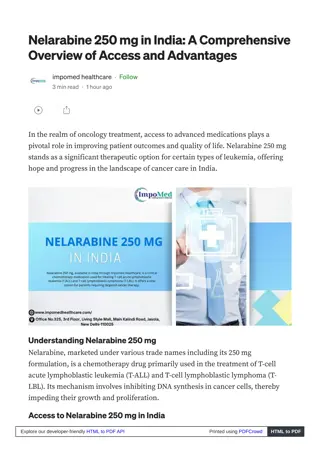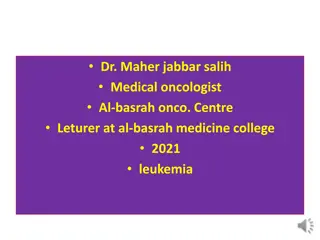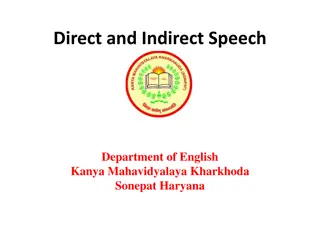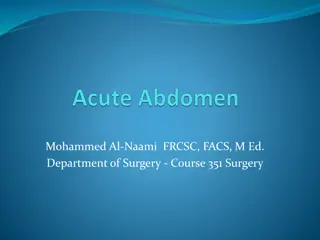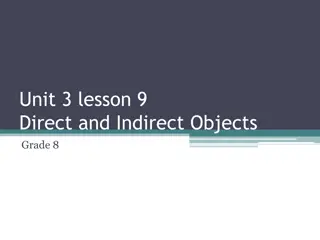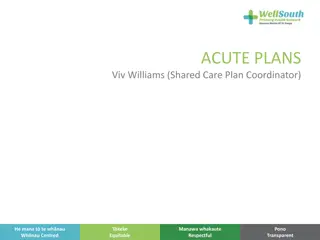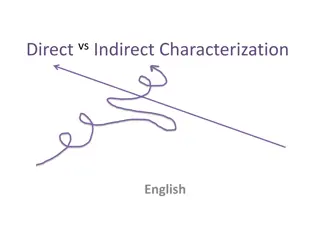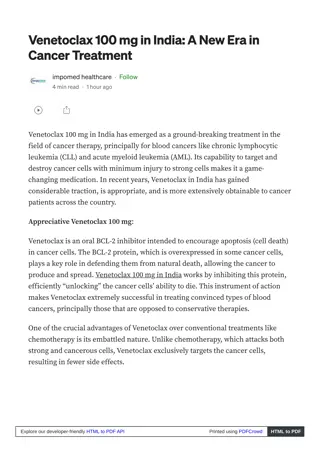Indirect Treatment Comparison of Blinatumomab vs. Inotuzumab Ozogamicin in R/R Acute Lymphoblastic Leukemia
Aggressive type of leukemia - R/R Ph- B-precursor ALL prognosis poor. Blinatumomab and InO are treatment options, but no direct comparison trials available. Objective of this study was to indirectly compare efficacy of blinatumomab vs. InO in adult patients with R/R ALL who had received zero or one prior salvage therapy.
Download Presentation

Please find below an Image/Link to download the presentation.
The content on the website is provided AS IS for your information and personal use only. It may not be sold, licensed, or shared on other websites without obtaining consent from the author.If you encounter any issues during the download, it is possible that the publisher has removed the file from their server.
You are allowed to download the files provided on this website for personal or commercial use, subject to the condition that they are used lawfully. All files are the property of their respective owners.
The content on the website is provided AS IS for your information and personal use only. It may not be sold, licensed, or shared on other websites without obtaining consent from the author.
E N D
Presentation Transcript
PF187 European Hematology Association (EHA) 2018 Annual Meeting, Stockholm, Sweden: June 14-17 Indirect Treatment Comparison of Blinatumomab vs Indirect Treatment Comparison of Blinatumomab vs Inotuzumab Inotuzumab Ozogamicin Ozogamicinfor Treating Adult Patients With for Treating Adult Patients With Relapsed or Refractory Acute Lymphoblastic Leukemia Relapsed or Refractory Acute Lymphoblastic Leukemia Receiving Zero or One Prior Salvage Therapy Receiving Zero or One Prior Salvage Therapy Jinlin Song1, Qiufei Ma2, Wei Gao1, Ze Cong2, Jipan Xie1, Zachary Zimmerman2, Laura Belton3, Janet Franklin2, Stephen Palmer4 1Analysis Group, Inc., Boston, MA 02199, USA; 2Amgen Inc., Thousand Oaks, CA 91320, USA; 3LB Biostatistics, London, UK; 4University of York, York, YO105DD, UK Open Book SC-CH-AMG103-00096 1 Title Poster Introduction Objectives Methods Results Limitations Conclusions Disclosures References
Indirect Treatment Comparison of Blinatumomab vs Inotuzumab Ozogamicin for Treating Adult Patients With Relapsed or Refractory Acute Lymphoblastic Leukemia Receiving Zero or One Prior Salvage Therapy PF187 Introduction Acute lymphoblastic leukemia (ALL) is an aggressive type of leukemia characterized by the proliferation of immature lymphoid cells in the bone marrow, peripheral blood, and other organs The prognosis of relapsed or refractory (R/R) Philadelphia chromosome- negative (Ph-) B-precursor ALL for adult patients is very poor: median overall survival (OS) is about 3 6 months with salvage chemotherapy1 Blinatumomab and inotuzumab ozagamicin (InO) are two options recommended by the latest National Comprehensive Cancer Network guidelines for treating adult patients with R/R ALL2 There are no randomized head-to-head trials that have compared the efficacy of blinatumomab vs. InO There are differences in study design and patient characteristics between the Phase III trials of blinatumomab and InO, which make direct comparisons of reported treatment efficacy results challenging Open Book 3 Title Poster Introduction Objectives Methods Results Limitations Conclusions Disclosures References
Indirect Treatment Comparison of Blinatumomab vs Inotuzumab Ozogamicin for Treating Adult Patients With Relapsed or Refractory Acute Lymphoblastic Leukemia Receiving Zero or One Prior Salvage Therapy PF187 Objectives Objectives To indirectly compare the efficacy of blinatumomab vs. InO among adult patients with R/R ALL who received zero or one prior salvage therapy, adjusting for cross-trial differences Open Book 4 Title Poster Introduction Objectives Methods Results Limitations Conclusions Disclosures References
Indirect Treatment Comparison of Blinatumomab vs Inotuzumab Ozogamicin for Treating Adult Patients With Relapsed or Refractory Acute Lymphoblastic Leukemia Receiving Zero or One Prior Salvage Therapy PF187 Methods Methods Data Sources Patient-level data for the blinatumomab and the SOC arms of the Phase III trial TOWER was used in the analyses3 Aggregated data for the InO and the SOC arms of the Phase III trial INO-VATE was extracted from publications4,5 Open Book 5 Title Poster Introduction Objectives Methods Results Limitations Conclusions Disclosures References
Indirect Treatment Comparison of Blinatumomab vs Inotuzumab Ozogamicin for Treating Adult Patients With Relapsed or Refractory Acute Lymphoblastic Leukemia Receiving Zero or One Prior Salvage Therapy PF187 Methods (continued) Methods (continued) Sample Selection The study populations of the INO-VATE and TOWER trials were adults with R/R ALL, Eastern Cooperative Oncology Group (ECOG) performance status 2, and without any active central nervous system or isolated extramedullary disease The INO-VATE trial only enrolled patients with zero or one prior salvage therapy. To ensure fair comparisons vs the INO-VATE population, patients with more than one previous salvage treatment were excluded from the TOWER population in this analysis Open Book 6 Title Poster Introduction Objectives Methods Results Limitations Conclusions Disclosures References
Indirect Treatment Comparison of Blinatumomab vs Inotuzumab Ozogamicin for Treating Adult Patients With Relapsed or Refractory Acute Lymphoblastic Leukemia Receiving Zero or One Prior Salvage Therapy PF187 Methods (continued) Methods (continued) Outcomes The efficacy outcomes of interest included the percent of patients achieving complete remission with full hematologic recovery (CR) and OS OS curves were extracted from the published Kaplan- Meier curves using digitization software. Approximate patient-level data of death and time to death were generated using the approach described by Guyot et al. Restricted mean survival time (RMST) at 12 months was estimated and compared across treatments to assess the cumulative treatment effect without imposing the proportional hazards (PH) assumption Open Book 7 Title Poster Introduction Objectives Methods Results Limitations Conclusions Disclosures References
Indirect Treatment Comparison of Blinatumomab vs Inotuzumab Ozogamicin for Treating Adult Patients With Relapsed or Refractory Acute Lymphoblastic Leukemia Receiving Zero or One Prior Salvage Therapy PF187 Methods (Continued) Methods (Continued) Statistical Methods Matching-adjusted indirect comparisons (MAICs)6 were conducted to compare the efficacy outcomes between blinatumomab and InO for treating adult patients with R/R ALL who received zero or one prior salvage therapy Patients in the TOWER trial were weighted to match the average baseline characteristics reported in the INO-VATE trial. The individual patient weights were estimated from a logistic regression model using the method of moments The matched baseline characteristics included sex, age, race, ECOG performance status, bone marrow blast levels, previous salvage therapy, previous allogeneic transplantation, CR to most recent induction therapy, and duration of first remission These baseline characteristics were selected based on their availability in both trials, and their potential to be treatment effect modifiers according to the results from subgroup analyses in TOWER and INO-VATE Open Book 8 Title Poster Introduction Objectives Methods Results Limitations Conclusions Disclosures References
Indirect Treatment Comparison of Blinatumomab vs Inotuzumab Ozogamicin for Treating Adult Patients With Relapsed or Refractory Acute Lymphoblastic Leukemia Receiving Zero or One Prior Salvage Therapy PF187 Methods (Continued) The weighted efficacy outcomes for blinatumomab were statistically compared to the observed efficacy outcomes for InO in the balanced trial populations, with and without being anchored on the SOC arm CR rates were compared using chi-squared tests before matching and weighted Wald tests after matching OS curves were compared using log-rank tests, and RMSTs were compared using Wald tests Open Book 9 Title Poster Introduction Objectives Methods Results Limitations Conclusions Disclosures References
Indirect Treatment Comparison of Blinatumomab vs Inotuzumab Ozogamicin for Treating Adult Patients With Relapsed or Refractory Acute Lymphoblastic Leukemia Receiving Zero or One Prior Salvage Therapy PF187 Results Baseline Characteristics A total of 203 patients receiving blinatumomab, 107 patients receiving SOC chemotherapy were included from TOWER, and 164 patients receiving InO and 162 receiving SOC chemotherapy were included from INO-VATE Before matching, the TOWER population was younger, included fewer Asians, more Whites, more patients with previous salvage therapies or HSCT, and had higher bone marrow blasts, compared to the INO-VATE population After applying weights to patients enrolled in TOWER, the summary statistics of the baseline characteristics matched those of the INO-VATE population Open Book 10 Title Poster Introduction Objectives Methods Results Limitations Conclusions Disclosures References
Indirect Treatment Comparison of Blinatumomab vs Inotuzumab Ozogamicin for Treating Adult Patients With Relapsed or Refractory Acute Lymphoblastic Leukemia Receiving Zero or One Prior Salvage Therapy PF187 Table 1: Baseline Characteristics Before and After Matching Abbreviations: ECOG - Eastern Cooperative Oncology Group; HSCT - hematopoeitic stem cell transplantation; InO inotuzumab ozogamicin; SOC - standard of care. Note: a In the INO-VATE trial, the median ages were 46.5 years for the InO arm and 47.5 years for the SOC chemotherapy arm. Open Book 11 Title Poster Introduction Objectives Methods Results Limitations Conclusions Disclosures References
Indirect Treatment Comparison of Blinatumomab vs Inotuzumab Ozogamicin for Treating Adult Patients With Relapsed or Refractory Acute Lymphoblastic Leukemia Receiving Zero or One Prior Salvage Therapy Results (Continued) CR PF187 A slightly higher percentage of patients treated with blinatumomab achieved CR before (37.4%) and after (36.9%) matching compared to the patients treated with InO (33.5%). The differences were not statistically significant When the CR rate of active treatment arms was anchored on the SOC arms, blinatumomab was associated with a similar relative CR rate before matching (17.8%) and a slightly lower relative CR rate after matching (14.7%) compared to InO (17.5%). The differences were not statistically significant Open Book 12 Title Poster Introduction Objectives Methods Results Limitations Conclusions Disclosures References
Indirect Treatment Comparison of Blinatumomab vs Inotuzumab Ozogamicin for Treating Adult Patients With Relapsed or Refractory Acute Lymphoblastic Leukemia Receiving Zero or One Prior Salvage Therapy PF187 Results (Continued) CR (Table 2) Before Matching After Matching TOWER vs. INO-VATE TOWER vs. INO-VATE INO-VATE (INO) TOWER Difference (95% CI) P- TOWER Difference (95% CI) P-value (Blinatumomab) value (Blinatumomab) Active treatment 33.5% 37.4% 3.9% ( 5.9%, 13.7%) 0.437 36.9% 3.3% ( 6.8%, 13.5%) 0.520 SOC 16.0% 19.6% 3.6% ( 5.9%, 13.0%) 0.458 22.2% 6.2% ( 4.4%, 16.8%) 0.254 Active treatment SOC 17.5% 17.8% 0.3% ( 13.3%, 14.0%) 0.963 14.7% 2.8% ( 17.5%, 11.9%) 0.705 Abbreviations: CI - confidence interval; CR - complete remission with full hematological recovery; InO - inotuzumab ozogamicin SOC - standard of care Open Book 13 Title Poster Introduction Objectives Methods Results Limitations Conclusions Disclosures References
Indirect Treatment Comparison of Blinatumomab vs Inotuzumab Ozogamicin for Treating Adult Patients With Relapsed or Refractory Acute Lymphoblastic Leukemia Receiving Zero or One Prior Salvage Therapy PF187 Results (Continued) OS The median OS for blinatumomab increased from 8.4 (95% CI: 6.4, 10.8) months before matching to 9.3 (7.5, 14.3) months after matching, and both were higher than the median OS for InO (7.7 [6.3, 9.2] months). No differences were found between the OS curves for blinatumomab and InO before (log-rank test p = 0.8) or after matching (p = 0.4) (Figure 1) The PH assumption was violated for blinatumomab vs. InO (p < 0.05 before matching and p < 0.01 after matching) At 12 months, the RMST for blinatumomab increased from 7.42 (95% CI: 6.78, 8.06) months to 7.77 (7.02, 8.53) months after matching. While anchored on the SOC arms, the RMST for blinatumomab was higher than that for InO both before (difference [95% CI]: 1.02 [ 0.41, 2.44] months) and after (1.62 [0.06, 3.19] months) matching, and the difference in after- matching anchored RMST was statistically significant (p < 0.05) (Table 3) Open Book 14 Title Poster Introduction Objectives Methods Results Limitations Conclusions Disclosures References
Indirect Treatment Comparison of Blinatumomab vs Inotuzumab Ozogamicin for Treating Adult Patients With Relapsed or Refractory Acute Lymphoblastic Leukemia Receiving Zero or One Prior Salvage Therapy PF187 Results (Continued) Results (Continued) Open Book 15 Title Poster Introduction Objectives Methods Results Limitations Conclusions Disclosures References
Indirect Treatment Comparison of Blinatumomab vs Inotuzumab Ozogamicin for Treating Adult Patients With Relapsed or Refractory Acute Lymphoblastic Leukemia Receiving Zero or One Prior Salvage Therapy PF187 Table 3: Comparison of RMST at 12 Months Before and After Matching (Months) Before Matching After Matching TOWER vs. INO-VATE TOWER vs. INO-VATE INO-VATE (INO) TOWER Difference (95% CI) P-value TOWER Difference (95% CI) P-value (Blinatumomab) (Blinatumomab) Active treatment 7.60 7.42 0.18 ( 1.06, 0.70) 0.69 7.77 0.15 ( 0.81, 1.11) 0.76 SOC 6.91 5.71 -- -- 5.46 -- -- Active treatment SOC 0.70 1.71 1.02 ( 0.41, 2.44) 0.16 2.31 1.62 (0.06, 3.19) < 0.05 Open Book 16 Title Poster Introduction Objectives Methods Results Limitations Conclusions Disclosures References
Indirect Treatment Comparison of Blinatumomab vs Inotuzumab Ozogamicin for Treating Adult Patients With Relapsed or Refractory Acute Lymphoblastic Leukemia Receiving Zero or One Prior Salvage Therapy PF187 Limitations Limitations While MAIC accounted for the imbalance from observed baseline characteristics, differences between the trials in unobserved baseline characteristics may also impact outcomes, and were not eliminated in this analysis Some baseline differences between TOWER and INO-VATE could not be eliminated due to a lack of overlap in the patient population. For example, the INO-VATE trial included both Ph- and Ph+ patients while the TOWER trial only included Ph- patients Open Book 17 Title Poster Introduction Objectives Methods Results Limitations Conclusions Disclosures References
Indirect Treatment Comparison of Blinatumomab vs Inotuzumab Ozogamicin for Treating Adult Patients With Relapsed or Refractory Acute Lymphoblastic Leukemia Receiving Zero or One Prior Salvage Therapy PF187 Limitations (Continued) The SOC arm for TOWER had a shorter median OS and RMST than the SOC arm for INO-VATE. The cause of the difference may need further investigation Some relevant outcomes could not be compared due to the differences in their definitions in TOWER and INO-VATE, including complete remission with incomplete hematologic recovery (CRi), complete remission with partial hematologic recovery (CRh), and duration of remission (DOR) HSCT is driven by multiple factors beyond the treatments, such as the availability of appropriate donors, which cannot be adjusted for using the current data and therefore was not compared in the current study Open Book 18 Title Poster Introduction Objectives Methods Results Limitations Conclusions Disclosures References
Indirect Treatment Comparison of Blinatumomab vs Inotuzumab Ozogamicin for Treating Adult Patients With Relapsed or Refractory Acute Lymphoblastic Leukemia Receiving Zero or One Prior Salvage Therapy PF187 Conclusions After adjusting for heterogeneity in patient characteristics between the trial populations, blinatumomab exhibited a similar CR rate as InO and a potential survival benefit, with statistically significantly longer RMST at 12 months Open Book 19 Title Poster Introduction Objectives Methods Results Limitations Conclusions Disclosures References
Indirect Treatment Comparison of Blinatumomab vs Inotuzumab Ozogamicin for Treating Adult Patients With Relapsed or Refractory Acute Lymphoblastic Leukemia Receiving Zero or One Prior Salvage Therapy PF187 Disclosures This study was supported by Amgen Inc QM, ZC, ZZ, and JF are employees of Amgen and hold Amgen stock LB reports no conflicts of interest JS, WG, and JX are employees of Analysis Group, Inc., which received consulting fees from Amgen SP has received consulting fees from Amgen Open Book 20 Title Poster Introduction Objectives Methods Results Limitations Conclusions Disclosures References
Indirect Treatment Comparison of Blinatumomab vs Inotuzumab Ozogamicin for Treating Adult Patients With Relapsed or Refractory Acute Lymphoblastic Leukemia Receiving Zero or One Prior Salvage Therapy PF187 References 1. G kbuget N, Dombret H, Ribera JM, Fielding AK, Advani A, Bassan R, et al. International reference analysis of outcomes in adults with B-precursor Ph-negative relapsed/refractory acute lymphoblastic leukemia. Haematologica. 2016;101(12):1524-33. 2. National Comprehensive Cancer Network (NCCN). NCCN Clinical Practice Guidelines in Oncology. Acute Lymphoblastic Leukemia. 2018. Accessed on: April 24, 2018. Available from: https://www.nccn.org/professionals/physician_gls/pdf/all.pdf. 3. Kantarjian H, Stein A, Gokbuget N, Fielding AK, Schuh AC, Ribera JM, et al. Blinatumomab versus Chemotherapy for Advanced Acute Lymphoblastic Leukemia. N Engl J Med. 2017;376(9):836-47. 4. Kantarjian HM, DeAngelo DJ, Stelljes M, Martinelli G, Liedtke M, Stock W, et al. Inotuzumab Ozogamicin versus Standard Therapy for Acute Lymphoblastic Leukemia. N Engl J Med. 2016;375(8):740-53. 5. European Medicines Agency. Assessment report: Besponsa Accessed on: April 24, 2018. Available from: http://www.ema.europa.eu/docs/en_GB/document_library/EPAR_- _Public_assessment_report/human/004119/W C500231263.pdf. 6. Signorovitch JE, Sikirica V, Erder MH, Xie J, Lu M, Hodgkins PS, et al. Matching-adjusted indirect comparisons: a new tool for timely comparative effectiveness research. Value Health. 2012;15(6):940-7. Open Book 21 Title Poster Introduction Objectives Methods Results Limitations Conclusions Disclosures References
